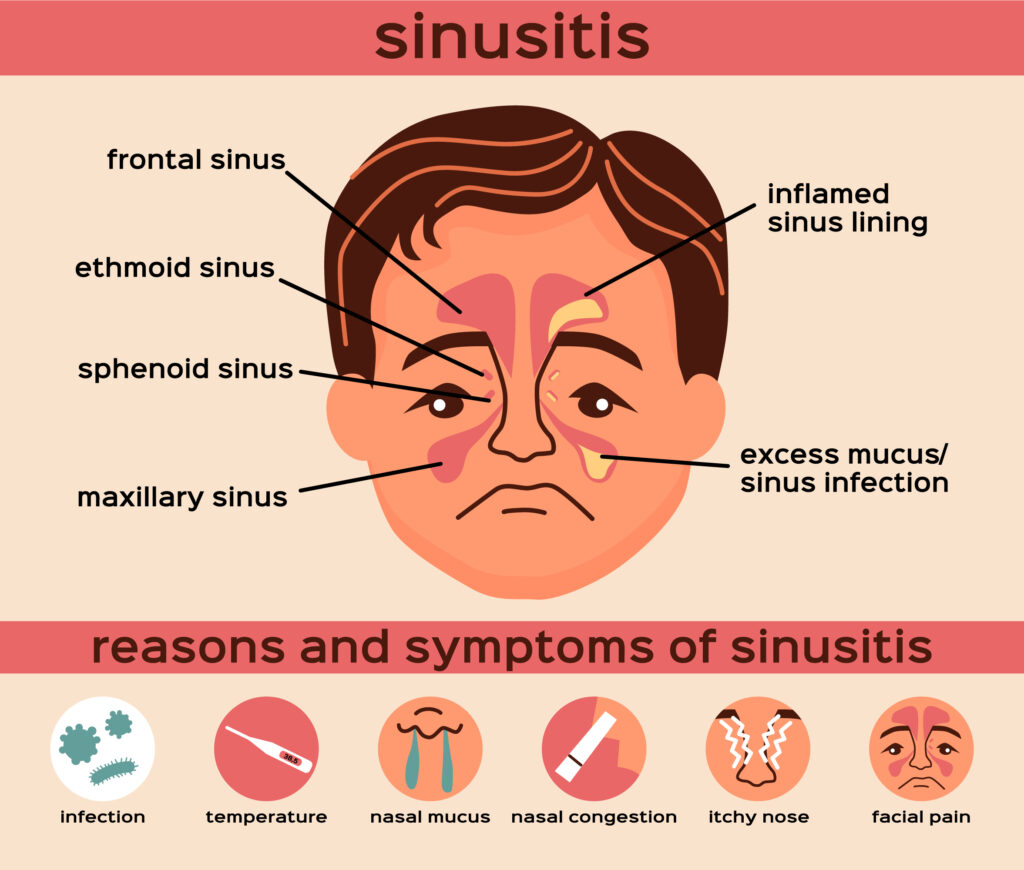
The term “sinusitis” refers to an enlargement or inflammation of the sinus tissue. The skull has four pairs of sinuses, which are cavities or gaps. They are connected by tiny passageways. A thin mucus produced by the sinuses is expelled through the nasal passages. This drainage aids in keeping the nose germ-free and clean. Although they are usually filled with air, sinuses can clog and fill with fluid. The emergence of bacteria could lead to the development of a disease (bacterial sinusitis). Rhino, from the Latin for “nose,” is also known as sinusitis. If the sinus tissue is inflamed, the nasal tissue will typically always enlarge.
Antibiotics are not typically necessary for sinus infections, but your doctor can decide if you need them.
What causes sinusitis?
Anyone can develop a sinus infection. Nonetheless, sinusitis is more likely to affect persons who have nasal allergies, nasal polyps, asthma, or atypical nose structures. Moreover, smoking can increase the frequency of sinus infections.
Causes:
When fluid assembles in the air-filled face pockets, sinus infections result (sinuses). Because of the fluid accumulation, germs might thrive. Although certain sinus infections can also be brought on by bacteria, viruses still account for the majority of sinus infections.
Symptoms:
The following are typical signs of sinus infections:
- Clogged nose.
- Facial pressure or pain.
- Headache.
- The throat was pouring with mucus. (post-nasal drip)
- Unwell throat.
- Cough.
- Poor breath.
Risk Elements :
There are several things that can make you more likely to acquire a sinus infection:
- An earlier cold.
- Seasonal sensitivity.
- Secondhand smoke exposure and smoking.
- Internal sinus structural issues. For instance, nasal polyps, which are growths on the sinus or nose lining.
- Having a weakened immune system or using immune-depressing medications.
The procedure used to identify sinusitis:
In order to understand your symptoms and compile a thorough medical history, your healthcare professional will ask you a number of questions. Moreover, a physical examination will be done. In order to determine whether there is any swelling, discharge, or obstruction, your doctor will examine your throat, nose, and ears. An endoscope, a tiny lighted/optical instrument, can be used to see inside the nose. You could occasionally be offered the name of an ENT expert (ear, nose, and throat). Your medical professional would request a computed tomography (CT) scan if you required an imaging test.
When to Get Medical Attention:
- If you experience Serious symptoms, such as a severe headache or facial pain, consult a doctor.
- Symptoms that worsen after they get better.
- Also, if you have experienced several sinus infections in the last year, contact a doctor.
- This is not a comprehensive list. If you have any symptoms that are serious or worrisome, please visit a doctor.
Treatment:
Your doctor will examine you and ask you about your symptoms to determine if you have a sinus infection.
Many sinus infections can be treated without antibiotics. Without drugs, most sinus infections typically recover on their own. Antibiotics won’t help you if you don’t need them, and their adverse effects could still be dangerous. From minor reactions, like a rash, to more serious health issues, side effects can vary widely. Severe allergic responses, infections that are resistant to antibiotics, and C. diff infections are a few of these issues. Diarrhea brought on by C. diff can cause serious colon damage and even death.
Yet occasionally, you could require antibiotics. Consult your doctor about the best course of action for your condition. For some sinus infections, your doctor may advise watchful waiting or delaying the prescription of antibiotics.
Watchful waiting: Your doctor could advise waiting two to three days to see if you need antibiotics. The immune system has more time to fight the sickness as a result. If your symptoms don’t improve, the doctor might advise an antibiotic. a postponed prescription If your doctor issues you an antibiotic prescription, they may advise you to wait two to three days before filling it. It’s possible that you won’t need the antibiotic to heal.
Tips for Feeling Better:
The following are some methods to reduce sinus pressure and pain:
To help reduce sinus congestion, apply a warm compress to the forehead and nose. Employ saline nasal spray or a decongestant. Take a shower or a bowl of hot water and inhale the steam. Find out about over-the-counter medications that can make you feel better by speaking to your doctor or pharmacist. Use over-the-counter medications only as instructed.
Prevention:
- By trying your best to be well and keep others healthy, including: washing your hands, you may be able to prevent sinus infections.
- Vaccinate yourself as directed, including with the pneumococcal and flu vaccines.
- Avoid those who have the flu or other upper respiratory illnesses because they are contagious.
- Refrain from smoking and taking in smoke.
- To wet the air in your home, use a dependable humidifier.